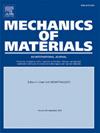Multi-mechanism damage-coupled constitutive model for ratchetting-fatigue interaction of extruded AZ31 magnesium alloy
IF 3.4
3区 材料科学
Q2 MATERIALS SCIENCE, MULTIDISCIPLINARY
引用次数: 0
Abstract
Magnesium (Mg) alloys have attracted much attention because of their advantage in lightweight design, and a theory of fatigue damage is a key issue for their engineering applications. Therefore, to capture the failure process of extruded AZ31 Mg alloy under complex stress states, a multi-mechanism damage-coupled constitutive model is constructed to reasonably describe the ratchetting-fatigue interaction of extruded AZ31 Mg alloy in the framework of continuum damage mechanics. Based on the multi-mechanism cyclic plastic constitutive model, the so-called pure fatigue damage caused by the plastic deformation resulted from different mechanisms (i.e., dislocation slipping and twinning/detwinning) is innovatively considered. Thus, two distinct evolution rules are formulated to account for two pure fatigue damage parts, respectively, and specifically addressing the coupling of such two damage parts. In addition, in view of significant ratchetting occurred in the extruded AZ31 Mg alloy under the loading conditions with high mean stresses and at elevated temperatures, additional damage caused by ratchetting (denoted as ratchetting damage) is also introduced into the evolution rule of total damage variable. Compared with the experimental results, the multi-mechanism damage-coupled constitutive model proposed in this paper can effectively predict the whole-life ratchetting and fatigue life of extruded AZ31 Mg alloy under different deformation mechanisms and at elevated temperatures.
挤压AZ31镁合金棘轮-疲劳相互作用多机制损伤耦合本构模型
镁合金因其轻量化设计的优势而备受关注,疲劳损伤理论是镁合金工程应用的关键问题。因此,为了捕捉挤压AZ31镁合金在复杂应力状态下的破坏过程,建立了多机制损伤耦合本构模型,在连续损伤力学框架下合理描述挤压AZ31镁合金的棘轮-疲劳相互作用。在多机制循环塑性本构模型的基础上,创新性地考虑了不同机制(即位错滑移和孪生/去孪生)引起的塑性变形所造成的所谓纯疲劳损伤。因此,分别为两个纯疲劳损伤部件制定了两种不同的演化规则,并专门解决了这两个损伤部件的耦合问题。此外,鉴于挤压态AZ31镁合金在高平均应力和高温加载条件下存在明显的棘轮损伤,将棘轮损伤引起的附加损伤(记为棘轮损伤)引入总损伤变量的演化规律中。与试验结果比较,本文提出的多机制损伤耦合本构模型能够有效预测挤压AZ31镁合金在不同变形机制和高温下的全寿命棘轮和疲劳寿命。
本文章由计算机程序翻译,如有差异,请以英文原文为准。
求助全文
约1分钟内获得全文
求助全文
来源期刊

Mechanics of Materials
工程技术-材料科学:综合
CiteScore
7.60
自引率
5.10%
发文量
243
审稿时长
46 days
期刊介绍:
Mechanics of Materials is a forum for original scientific research on the flow, fracture, and general constitutive behavior of geophysical, geotechnical and technological materials, with balanced coverage of advanced technological and natural materials, with balanced coverage of theoretical, experimental, and field investigations. Of special concern are macroscopic predictions based on microscopic models, identification of microscopic structures from limited overall macroscopic data, experimental and field results that lead to fundamental understanding of the behavior of materials, and coordinated experimental and analytical investigations that culminate in theories with predictive quality.
 求助内容:
求助内容: 应助结果提醒方式:
应助结果提醒方式:


